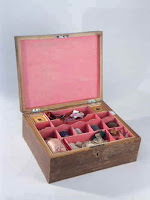 A few months ago I blogged about dumb luck in a box and shared my discoveries on those most gorgeous of items, portable Regency writing desks. While searching around for illustrations I came across some sewing boxes from the same period and decided that at some point I should blog about those too. Naturally that got me going online in all sorts of strange directions, and squeaking OMG I want that! And that! from time to time.
A few months ago I blogged about dumb luck in a box and shared my discoveries on those most gorgeous of items, portable Regency writing desks. While searching around for illustrations I came across some sewing boxes from the same period and decided that at some point I should blog about those too. Naturally that got me going online in all sorts of strange directions, and squeaking OMG I want that! And that! from time to time.Somehow I doubt I'll take up embroidery but it was close, very close, for a few minutes.
Work, for genteel women, meant sewing or embroidery, and the idea of it being a suitable, sociable occupation for women lasted well into the twentieth century. Many projects required embroidery--handkerchiefs, linens. Sometimes men embroidered too--it was a favorite pastime of sailors. One of my aunts, who worked for the Admiralty in the 1940s, surprised her boss with his embroidery project in hand.
Here's a favorite scene from one of my favorite books--the first meeting between Seth and Flora Post in Cold Comfort Farm (I have just bought yet another replacement copy to have it disappear into my daughter's reading maw).
Flora saw at once that he was not the kind that could be fobbed of with offers of tea. She was for it.
"What's that you're making?" he asked. Flora knew that he hoped it was a pair of knickers. She composedly shook out the folds of the petticoat and replied that it was an afternoon tea-cloth.

 Here's a sewing box from c. 1800, still with its original pink paper lining, exquisitely made. The box is maple with a hand-colored print on the top.
Here's a sewing box from c. 1800, still with its original pink paper lining, exquisitely made. The box is maple with a hand-colored print on the top.
The sewing tools are made of Tunbridge ware whitewood, a process of wood mosaic originally developed to make souvenirs for those visiting the spa at Tunbridge Wells, Kent. More about Tunbridge ware here.
Does anyone know what the little bottles would have held? Images are from Antique Boxes at the Sign of the Hygra in London.
 One very popular form of embroidery work was embroidery with narrow silk ribbons instead of thread--fast, simple, and decorative. The Jane Austen Centre, Bath, magazine has a great article about it here. If you wish to explore further, Threads published an article on the basic stitches and you can buy supplies at ribbonsmyth.com.
One very popular form of embroidery work was embroidery with narrow silk ribbons instead of thread--fast, simple, and decorative. The Jane Austen Centre, Bath, magazine has a great article about it here. If you wish to explore further, Threads published an article on the basic stitches and you can buy supplies at ribbonsmyth.com. An early form of needlepoint, Berlin woolwork, was becoming popular in the Regency, particularly to make the uppers for slippers, which would then be taken to a shoemaker to have the soles attached. These child's slippers, possibly American, date from around 1840, although Berlin woolwork peaked in England with the 1851 Great Exhibition.
An early form of needlepoint, Berlin woolwork, was becoming popular in the Regency, particularly to make the uppers for slippers, which would then be taken to a shoemaker to have the soles attached. These child's slippers, possibly American, date from around 1840, although Berlin woolwork peaked in England with the 1851 Great Exhibition. Here are some more gorgeous sewing boxes at Hampton Antiques and Gerald Mathias and some great pictures of this tortoiseshell needle box here--yes, it looks like a snuff box until you open it up, and it has its original paper lining.
Here are some more gorgeous sewing boxes at Hampton Antiques and Gerald Mathias and some great pictures of this tortoiseshell needle box here--yes, it looks like a snuff box until you open it up, and it has its original paper lining. Here's an article about the development of the famous Mountmellick whitework embroidery industry, started early in the nineteenth century in the northern Irish town of the same name. Wikipedia has an entirely different set of dates, so take your pick...
Here's an article about the development of the famous Mountmellick whitework embroidery industry, started early in the nineteenth century in the northern Irish town of the same name. Wikipedia has an entirely different set of dates, so take your pick...Do you embroider or collect antique linens? Do you have any books or online sources you'd like to share?
No comments:
Post a Comment